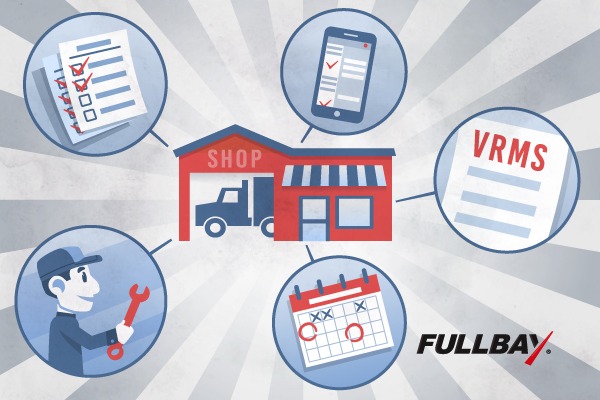7 Ways to Make Your Heavy Duty Shop More Productive

Putting together an all-star team of talented techs and proficient staff doesn’t always guarantee a productive shop. Many issues can arise to disrupt workflow and stand in the way of maximum productivity, such as not having the right parts in stock, waiting on customer approval, or how the shop is laid out. What’s more, the culture in a heavy duty shop can even affect how productive the techs are. Let’s take an in-depth look at how to increase shop productivity, starting with the processes, equipment, and organizing essentials for highly productive heavy duty shops.
1) Structure Your Shop for Productivity
Take a look at the layout of your shop. Is it organized in a way that keeps your techs and department managers running back and forth all day? If so, you will increase shop productivity by rearranging things logically. For example, diagnostic computers, jack stands, and other frequently-used large tools should be kept where techs can easily access them. Plus, it should be procedure to put those items away after use. The stockroom should be near the repair bays. That keeps techs from having to trek to the other side of the building every time they start a job. Also, storage rooms should be organized, as well, so no one has to search for parts and supplies when they need them.
2) Increase Shop Productivity with the Right Equipment
It’s no secret that specialized equipment and tools are essential for a heavy duty shop. However, many times techs have to make do with outdated, damaged, or defective equipment. That could be anything from a computer to an air compressor to an incomplete socket set. Replace, repair, or upgrade the necessary pieces. Sure, it’s an expense, but having the right working equipment will increase shop productivity.
Additionally, if your shop doesn’t have truck lifts, consider adding them to your equipment list. Not many heavy duty shops use them because, in the past, techs could access the underside of a semi on a creeper. That’s a little harder with the design of newer trucks, but the best reason for a heavy duty repair shop to use vehicle lifts is that they increase shop productivity. Studies have shown that using lifts decrease time spent on jobs by an average of 40 percent. How much would your team accomplish with almost 50 percent more time each day?
3) Make Sure There’s Work To Do
A well-planned shop filled with cutting-edge tools and manned with skilled technicians can’t be productive without enough work to do. It’s the owner’s job to ensure the work is there to keep the techs busy and productive. Start by tracking the truck count each week so you can gauge how many jobs come in on average and how long it takes your techs to turn them out. Once you have those metrics, you can make some changes to increase shop productivity. That might mean cutting staff or adjusting their hours. Alternatively, you could do more marketing to bring up the truck count to keep all your techs busy.
4) Automate Processes
There are things that happen in a heavy duty shop over and over, day in and day out. Unfortunately, they’re so much a part of doing business that they become stumbling blocks that interfere with productivity. Intake inspections, check-in, and creating service orders—that’s just a sample of the typical tasks involved with a repair job. They all take place before the tech even gets assigned, and they eat up anywhere from 10 minutes to half an hour of time. Automating common tasks will speed things up and increase shop productivity.
Switching to a paperless system—we’ll talk about using technology in just a moment—and using universal standards like the Vehicle Maintenance Reporting Standards (VMRS) will streamline inspections and service order creation. Doing away with hand-written forms also eliminates misunderstandings from hard-to-read paperwork. It also cuts the extra time it takes to enter the info into your system. Plus, using VMRS is faster because it involves simply checking off code keys rather than writing out lengthy repair descriptions.
5) Revise Procedures
Considering how much has changed in heavy duty truck repair over the years, it’s essential to revise your procedures regularly. If you’re using the same methods and systems from even 5 years ago, you’re running on outdated information. Automating and switching to a paperless system is useful in this area, too. Those steps eliminate the need for service writers and mechanics to have an in-person conversation for every job. Cutting that element alone can save up to an hour on each repair.
Tap into your techs’ expertise, too. Get the guy who kills it when replacing brakes or working on transmissions to write his process down. Then, have all your techs follow his procedures. In fact, having a procedure for almost everything that goes on will increase shop productivity. Official, outlined processes give techs and the rest of the staff proven routines to follow to keep them at maximum productivity.
6) Schedule Smarter
Scheduling smarter applies to the number of techs on hand as well as to how jobs are doled out as they come in. First, use the truck count metrics from step 3 to schedule only the number of technicians you need each day. For example, if the middle of the week is the busiest for your shop, schedule more techs to work on Tuesday, Wednesday, and Thursday. Be flexible, though. Stay on top of the numbers from day to day. If you’re aware of what’s coming tomorrow as well as what happened a week ago, you can change the schedule accordingly.
When assigning jobs, it doesn’t make sense to simply hand them out to whoever is next in the rotation. Look at who is available, but also consider who is the best tech for each job. Maybe your transmission wizard is currently working on an oil change. But go ahead and assign the tranny job that just came through the door to him. He can handle them both, and he’ll do a better job on the transmission than anyone else. Moreover, give basic work like PMs and global services to less experienced techs. On slower days, you can distribute them equally, but take your techs’ strengths into account when scheduling jobs to increase shop productivity.
7) Use Technology to Increase Shop Productivity
We briefly touched on automating and going paperless to streamline heavy duty repair, but let’s talk about more ways technology can help increase shop productivity. Using repair shop software reduces paperwork clutter significantly, eliminates misunderstandings, and cuts the time techs and managers spend handwriting orders, recommendations, and invoices. It’s also an effective way to communicate with customers. Whether you cater to fleets or do business with individual owner-operators—or both!—technology helps you stay in touch with them and expedites everything from scheduling services to appointment reminders to getting approvals. Imagine how productive your shop would be with automatically scheduled PMs, no more missed appointments, and instant job approvals that only require the click of a button.
How Fullbay Can Help
If you’re ready to increase shop productivity, Fullbay can help. Fullbay collects data you need to track job numbers and techs’ time, and you can assign work and monitor technician progress with Fullbay, too. It automates processes like ordering and receiving parts, creating service orders, and invoicing. Plus, Fullbay has a customer portal that allows your clients to request repairs and services, approve work, and pay invoices, too. It’s like an assistant shop manager that lives in the Cloud, so you can access everything on your tablet or smartphone wherever you are. Fill in the form below to give Fullbay a try and experience shop productivity you never dreamed was possible.

